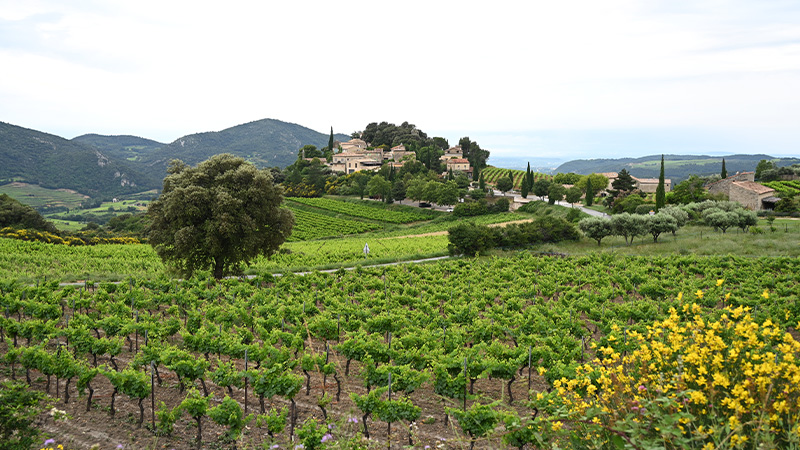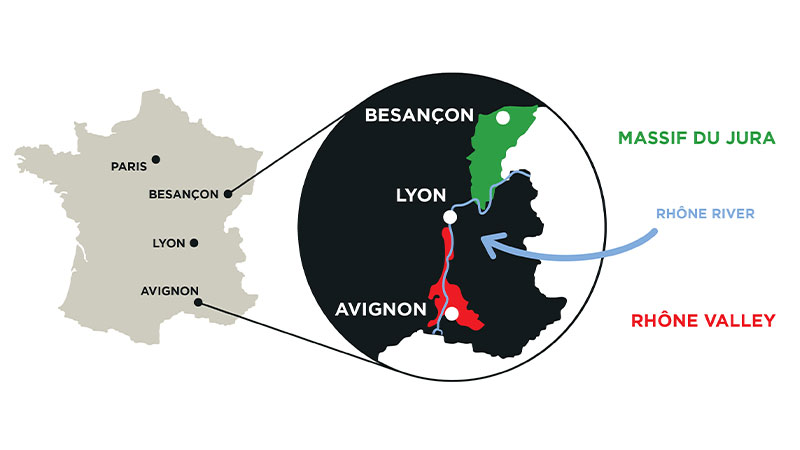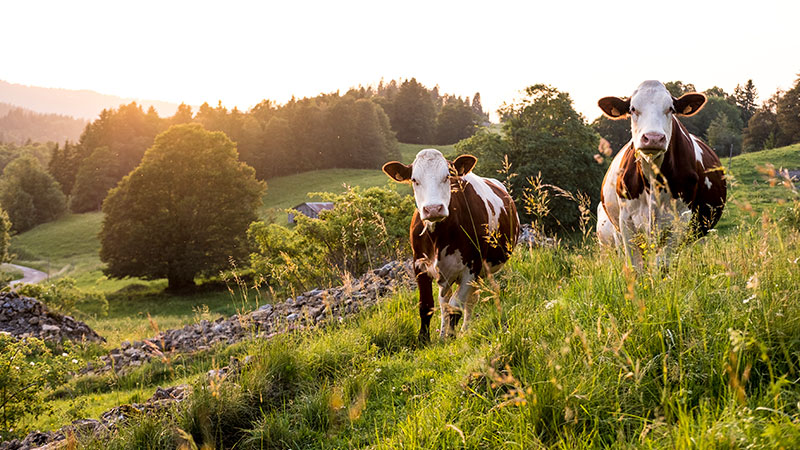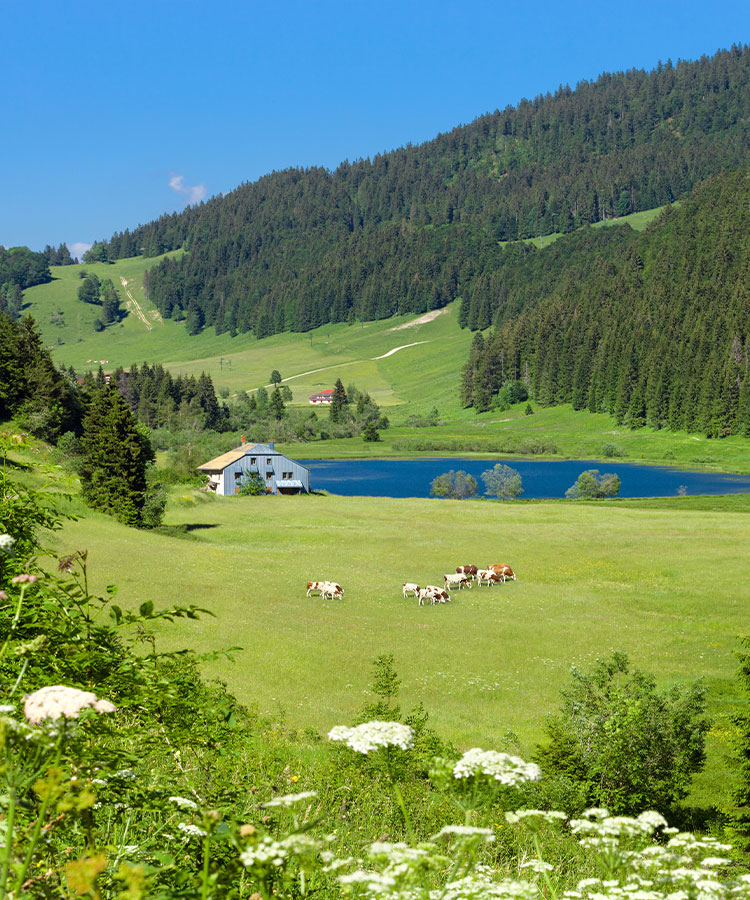
Few pairings go together as well as French wine and cheese. Nothing says France quite like a well-balanced wedge of Comté — fruity, savory, salty, and sweet — alongside a bold, full-bodied, and spicy Côtes du Rhône. However, few know the complementary nature of Comté and Côtes du Rhône stretches far beyond the table. Connected by the renowned Rhône River, these two regions are known for their expressive terroirs and exquisite eponymous wine and cheese products. To top it off, each bears Europe’s prestigious Protected Designation of Origin (PDO) label.

Earning a PDO distinction doesn’t happen overnight; it takes generations of work, dedication, and commitment. Only products that unmistakably represent their unique geographical terroirs, utilize generational knowledge, and incorporate local ingredients into production can earn a coveted PDO distinction. Still, this alone is not enough. An emphasis on heritage, deep-rooted respect for the land and community, and understanding the symbiosis between local biodiversity and cultivation are paramount.
Understanding the Geography

Bordering Switzerland to the west, Comté’s climate and the Jura mountains’ natural grasslands and floral valleys have provided the region with the perfect pastures for grazing dairy cows. The exceptional milk produced by Comté cows has been the source of the region’s famous mild, slightly sweet cheese for the last millennium.
Flanking the Rhône River from Lyon to Avignon, the steep slopes, rolling hills, and flat plains and plateaus of Côte du Rhône have been producing grapes for 2,000 years, dating back to cultivation during Greek and Roman times. Today, over 20 grape varieties are grown within Côtes du Rhône’s mistral-fed Mediterranean climate and from its unique river-fed terroir. Sand, gravel, granite rocks, and the region’s characteristic galets roulés all play a part in shaping the full-bodied, floral, and fresh attributes often associated with Côtes du Rhône’s red, rosé, and white wines. Galets roulés are mineral-rich quartzite rocks smoothed over time by water flow from glacier and river water. These rocks are distinctive in the Côtes du Rhône region. During sunny periods, they absorb heat from the sun and warm the vines through the night, which results in a more intense flavor.
A Modern Practice Rooted in Tradition

The standout tastes of Comté cheese and Côtes du Rhône wines are not left to chance. Both products ‘ traditional agriculture and production methods have been carefully passed down through generations of family farmers. Often, they rely heavily on local, sustainable practices that focus on preserving the biodiversity of each region, allowing the terroir to shine through in Comté cheese and Côte du Rhône wine. By implementing terroir protection, the land’s biodiversity is automatically benefitted.
Comté has over 2,400 local family farms raising cows for dairy production. When producing Comté, only local Montbéliarde and French Simmental breeds are allowed. These renowned breeds are especially suited to the mountainous landscapes of the region. They have grazed the natural pastures for hundreds of years. Farmers help preserve and control the land’s biodiversity by keeping the herds on the smaller side to prevent overgrazing and maintain a close connection to the animals. To provide a higher quality of life for the cows, the cows graze freely during the summer months and are fed with hay harvested in the pastures during the winter months. Milking takes place twice a day, every day. Since Comté is made with raw milk and derives much of its flavors from the terroir, which implies the protection of a broad floristic diversity in the pastures, the quality of the milk must be impeccable.
Regarding wine, over 3,700 multi-generational winegrowers in the Côtes du Rhône balance the natural diversity and welfare of the terroir by employing traditional land management techniques — it’s quality over quantity here, too. For example, although it results in a lower yield, in addition to the plateau and plains of the Côtes du Rhône, winegrowers also rely on terraced vineyards. This tiered, multilayered vineyard design utilizes the terroir’s natural steep slopes to help protect the grapes against soil erosion, frost, and heavy rainfall. It’s just one of several holistic viticulture techniques used to encourage soil recovery and prosperity. This is in addition to using floral fallow land, planting native trees, and employing headlands.
Comté and Côtes du Rhône exercise exceptional transparency concerning the consumer, creating continuing trust and preservation of this critical relationship in the soil-to-sale process. A new project encourages producers to use a QR code that allows consumers to trace the history of a bottle of Côtes du Rhône from grape to glass — we’ll “cheers” to that! As to Comté, the PDO is committed to excellence and dedicated to constantly honoring consumers’ confidence in it. Its specifications are detailed and available to anyone wanting to learn more about it. For example, affineurs must grade the Comté wheels before they go to market; only the best ones are awarded a green band, which is affixed around the wheel.
Comté and Côtes du Rhône create a fresh dynamic rooted in shared values, mindsets, and experiences. This outstanding love for history, heritage, and terroir of Comté and Côtes du Rhône producers create two of France’s most classic wine and cheese products that make for the perfect pairings, from terroir to table, in every bite and sip.
Funded by the European Union. Views and opinions expressed are however those of the author(s) and do not necessarily reflect those of the European Union or FranceAgriMER. Neither the European Union nor the granting authority can be held responsible for them.

This article is sponsored by Comté x Côtes du Rhône.
